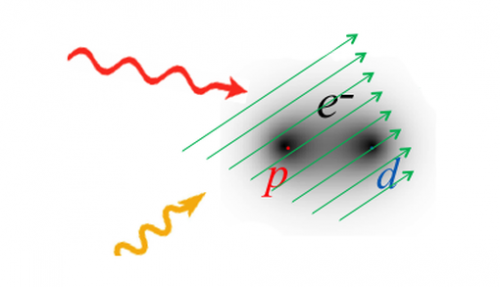July 16, 2014 report
Physicists propose molecular clock to expose new physics

(Phys.org) —A trio of researchers from Germany, Bulgaria and Russia has proposed the idea of using a molecular clock to determine if the electron-proton mass ratio changes over time. In their paper published in Physical Review Letters, Stephan Schiller, Dimitre Bakalov, and Vladimir Korobov describe a theoretical method for building such a clock and why if one were built, it might lead to new physics.
Everyone knows that atomic clocks are the gold standard for timing accuracy—they work by measuring the frequency of radiation as electrons from a single atom move from one energy level to another. In their paper, the researchers suggest that a molecular clock could be constructed by using a molecule with just two atoms and simultaneously combining multiple frequencies. They suggest such an approach could provide a more accurate assessment of whether the electron-proton mass ratio changes over time.
A lot of physics is based on the assumption that the mass of a proton remains constant over time—pretty much forever. But what if that's not true? What if it grows or shrinks over time? That would mean that the ratio between them and electrons changes as well, and if that's true, then physicists are going to have to come up with some new ideas to explain what that might mean. This is what Schiller et al are trying to find out, they suggest using molecular hydrogen-H2 or hydrogen-deuterium-HD+ as the molecular basis (compared to the larger caesium atoms normally used in atomic clocks) for a clock. In their paper they describe a theoretical method of using more than two combinations of frequencies and measuring them simultaneously, allowing the effects of shifts to be nearly canceled. Their calculations show that the uncertainty that would result from a combination frequency using HD+ would be as low as 5x10-18. To realize the goal of establishing whether the electron-proton mass ratio changes over time, the same experiment would have to be repeated several years later.
Building such a clock, would be challenging, the researchers acknowledge, but if it could be done, and if the results showed that proton mass does change, it could lead to the discovery of fundamental laws of physics that are not now currently known.
More information: Simplest Molecules as Candidates for Precise Optical Clocks, Phys. Rev. Lett. 113, 023004 – Published 8 July 2014. dx.doi.org/10.1103/PhysRevLett.113.023004
ABSTRACT
The precise measurement of transition frequencies in cold, trapped molecules has applications in fundamental physics, and extremely high accuracies are desirable. We determine suitable candidates by considering the simplest molecules with a single electron, for which the external-field shift corrections can be calculated theoretically with high precision. Our calculations show that H2+ exhibits particular transitions whose fractional systematic uncertainties may be reduced to 5×10−17 at room temperature. We also generalize the method of composite frequencies, introducing tailored linear combinations of individual transition frequencies that are free of the major systematic shifts, independent of the strength of the external perturbing fields. By applying this technique, the uncertainty of the composite frequency is reduced compared to what is achievable with a single transition, e.g., to the 10−18 range for HD+. Thus, these molecules are of metrological relevance for future studies.
Journal information: Physical Review Letters
© 2014 Phys.org



















